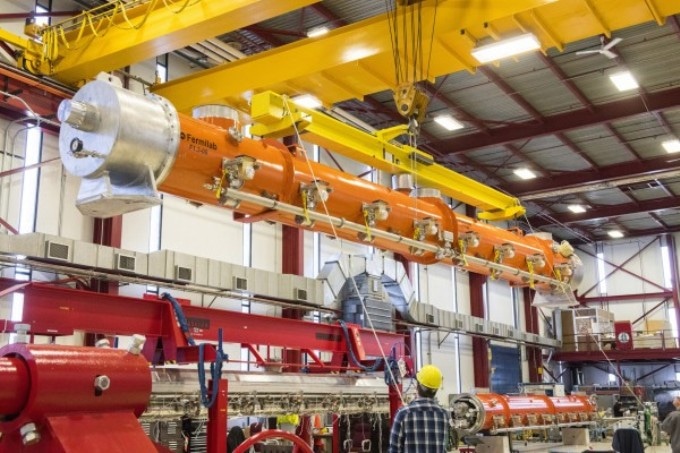Jan 23 2018
Researchers and engineers at the U.S. Department of Energy’s Fermilab in Illinois sent one of the most advanced, superconducting radio-frequency cryomodule ever built via a truck towards the west.
 The first cryomodule for SLAC’s LCLS-II X-ray laser departed Fermilab on January 16. (Image credit: Reidar Hahn)
The first cryomodule for SLAC’s LCLS-II X-ray laser departed Fermilab on January 16. (Image credit: Reidar Hahn)
That cryomodule arrived at the U.S. DOE’s SLAC National Accelerator Laboratory in California on January 19th. Here, it will become the first of 37, powering a three-mile-long machine that will transform atomic X-ray imaging. The modules are the product of a number of years of innovation in accelerator technology and the first cryomodule Fermilab built for this project created a world record in energy efficiency.
These modules, when arranged end to end, will make up the bulk of the accelerator that will power an enormous upgrade to the capabilities of the Linac Coherent Light Source at SLAC: a unique X-ray microscope that will use the brightest X-ray pulses ever made to deliver extraordinary details of the atomic world. Fermilab will provide 22 of the cryomodules, with the rest constructed and tested at the U.S. DOE’s Thomas Jefferson National Accelerator Facility in Virginia.
The quality factor accomplished in these components is unparalleled for superconducting radio-frequency cryomodules. The greater the quality factor, the lower the cryogenic load and the more efficiently the cavity imparts energy to the particle beam. Fermilab’s record-setting cryomodule doubled the quality factor compared to the earlier state-of-the-art.
LCLS-II represents an important technological step which demonstrates that we can build more efficient and more powerful accelerators. This is a major milestone for our accelerator program, for our productive collaboration with SLAC and Jefferson Lab and for the worldwide accelerator community.
Nigel Lockyer, Fermilab Director
This arrival is just the first. From now into 2019, the teams at Fermilab and Jefferson Lab will construct the remaining cryomodules, including extras, and inspect them from top to bottom, transporting them to SLAC only after they pass the stringent review.
It’s safe to say that this is the most advanced machine of its type. This upgrade will boost the power of LCLS, allowing it to deliver X-ray laser beams that are 10,000 times brighter than it can give us right now.
Elvin Harms, Fermilab Accelerator Physicist
With short, ultrabright pulses that will arrive up to a million times per second, LCLS-II will additionally sharpen their view of how nature functions at the smallest scales and help progress transformative technologies of the future, including novel electronics, life-saving drugs and ground-breaking energy solutions. Numerous scientists use LCLS annually to catch a sign of nature’s vital processes.
To comply with the machine’s standards, each Fermilab-constructed cryomodule must be examined in virtually identical conditions as in the actual accelerator. Each large metal cylinder - up to 40 ft in length and 4 ft in diameter - has accelerating cavities through which electrons zip at practically the speed of light. But the cavities, made of superconducting metal, must be maintained at a temperature of 2 K (minus 456 °F).
To realize this, ultracold liquid helium flows via pipes in the cryomodule and keeping that temperature stable is part of the testing process.
“The difference between room temperature and a few Kelvin creates a problem, one that manifests as vibrations in the cryomodule,” said Genfa Wu, a Fermilab scientist working on LCLS-II. “And vibrations are bad for linear accelerator operation.”
In preliminary tests of the prototype cryomodule, researchers discovered vibration levels that were higher than specification. To diagnose the issue, they used geophones - the same kind of equipment that can sense earthquakes - to exclude external vibration sources. They established that the cause was within the cryomodule and made several changes, including altering the path of the flow of liquid helium. The alterations worked, reducing vibration levels to a 10th of what they were initially, and have been effectively applied to succeeding cryomodules.
Fermilab researchers and engineers are also guaranteeing that undesirable magnetic fields in the cryomodule are maintained to a minimum, since too many magnetic fields decrease the operating efficiency.
At Fermilab, we are building this machine from head to toe. From nanoengineering the cavity surface to the integration of thousands of complex components, we have come a long way to the successful delivery of LCLS-II’s first cryomodule.
Nigel Lockyer, Fermilab Director
Fermilab has examined seven cryomodules, plus one constructed and earlier tested at Jefferson Lab, with significant success. Each of those, together with the modules yet to be constructed and examined, will undertake its own cross-country trip in the months and years to follow.
DOE’s Office of Science supports this project. LCLS is a DOE Office of Science user facility.
Fermilab is America’s premier national laboratory for particle physics research. A U.S. Department of Energy Office of Science laboratory, Fermilab is located near Chicago, Illinois and operated under contract by the Fermi Research Alliance, LLC. Visit Fermilab’s website at http://www.fnal.gov and follow us on Twitter @Fermilab.